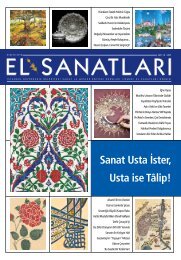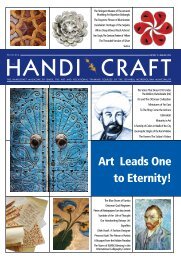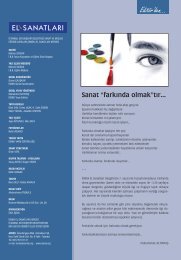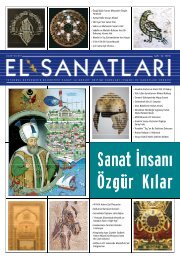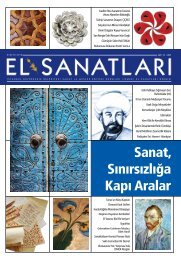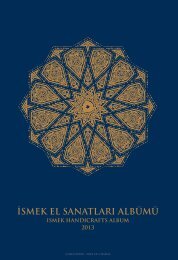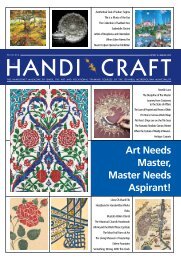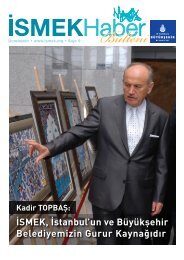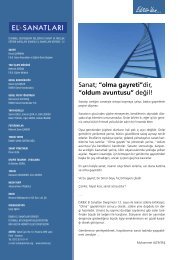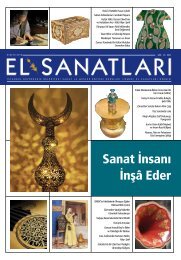Download Link - Ä°SMEK
Download Link - Ä°SMEK
Download Link - Ä°SMEK
You also want an ePaper? Increase the reach of your titles
YUMPU automatically turns print PDFs into web optimized ePapers that Google loves.
of ISMEK often comes to this shop which she sees by coincidence<br />
and does shopping from there. She has been buying the<br />
materials for embroidery needle craft, wire wrapping in Turkish<br />
way, wire breaking and ribbon.<br />
We’ve learned from Buyukasık that they have two shops in Antakya<br />
and a shop in Harbiye. Their customers in Antakya are<br />
generally local people. In the tradition of that region, in female<br />
trousseau, hand-made silk should be available. Silky materials<br />
aren’t only used for dress, young ladies do their handworks on<br />
raw silks, raw linens for their trousseau cloths.<br />
process well, you can feel the soul of the master who speaks<br />
with cocoons in each silk.<br />
We asked to Mehmet Buyukasık that “Are there any people<br />
who do this job in Antakya” He responded in the following<br />
way; “Other than us, there is my uncle’s son. For the last several<br />
days, other families start silk production. But, unfortunately,<br />
some families take the easy way out of the job and they bring<br />
silk from China and India and sell them in the name of Antakya<br />
silk. Our feature is that we do everything from silkworm to cocoon.<br />
In my grandfather’s time, my father, my uncles, they all<br />
did this job. Without spoiling this family tradition, cousins come<br />
to these days thanks to this strong attachment with each other.<br />
Silks Hidden In Chests<br />
Mehmet Buyukasık says that they use the patterns which the<br />
grandmothers take out of their chests. He explains that they<br />
sometimes blend with modern patterns with the patterns on<br />
which they apply according to the original forms of them. He<br />
shows some motifs they produce themselves. The harmony in<br />
patterns attracts our attentions. Especially, one of them, giving<br />
Antakya mosaic to the silk woven thinly as a pattern… But it is<br />
not transferred by copied and in the same way. When you look<br />
at carefully, you understand that it is a mosaic figure. 1000-<br />
year Antakya history is reflected on the weaving of silk with<br />
modern lines, slight touches. We wonder the customer profile<br />
of these valuable materials on which much effort is spent naturally.<br />
Mehmet Buyukasık says “Our customers in Istanbul, in<br />
respect to the location of this place, as we are in Sultanahmet<br />
are generally foreign customers.<br />
But he tells that he has many Turkish customers who prefer<br />
raw silk and some famous artists buy their foulards, weaving<br />
woof from them. Buyukasık tells that and also a female teacher<br />
Nostalgic Loom<br />
When we entered into Yılmaz silk shop, we’ve seen Buyukasık<br />
while he was working at his loom. We say to master Mehmet<br />
that we’ve thought that the loom is for décor and we’re surprised<br />
when we saw him while he was working. Buyukasık<br />
says, ”Everyday, I should sit at loom. The things I produce here<br />
are presented to be sold. In the day I don’t weave, I feel uncomfortable.<br />
This is like a therapy for me, I get rid of stress of the<br />
day only by this way.<br />
We say laughing that “We have noticed this. When we entered<br />
into the shop, you were like you were not here. You are<br />
very lucky, you both get rid of stress and gain money.” Again,<br />
Mehmet Buyukasık goes at the wooden loom. It is very obvious<br />
that he is having a different tie with his loom. While he is<br />
giving information about the materials he produces, we understand<br />
that he enjoys weaving rather than selling. We learn that<br />
warp silk strings are prepared in Antakya and sent by cargo<br />
and the foundation of warp takes about two days.<br />
He says that he weaves about three or four shawls in a day.<br />
He tells that since he was seven years old, he has been helping<br />
to his mother and he has done some small works. And he<br />
also says when he came to eleven years old, he found himself<br />
working at loom. He says laughing “When they handed over<br />
the loom at first, I was so happy that I can’t tell. The meaning of<br />
loom’s being handed over to me is the acceptance of my being<br />
adult after that day. I was like that I had grown up ten years.<br />
At that day, I remembered that I swaggered to my friends.” In<br />
order that this job become active again.<br />
Mehmet Buyukasık says that he met with a French couple last<br />
year. “They live in a village of France. In that village, since some<br />
centuries, the weaving has been done. The male one is producing<br />
wooden loom similar to ours. And his wife is weaving on<br />
the loom. We are in contact with them, they demanded string<br />
from us, and we sent to them,” says Buyukasık and states that<br />
it is a good feeling that there are people who do same job on<br />
different places, countries.<br />
82



